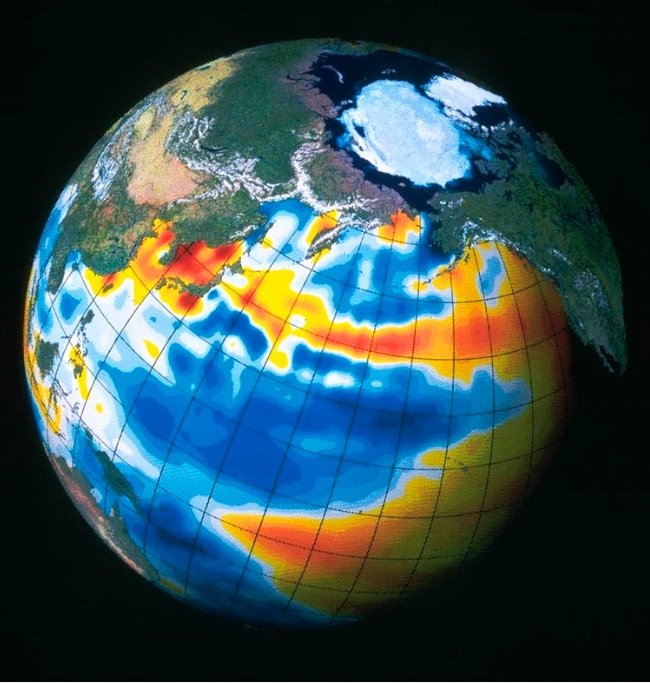World Ozone Day – not just a hole lot of hot air!
Happy World Ozone Day, otherwise known as the International Day for the Preservation of the Ozone Layer!
While the date might not have been pinned to your fridge door, it’s probably affected the way the fridge operates. In fact, the discovery of the ozone hole in 1984 and the subsequent introduction of ozone-friendly alternatives in the years that followed did more than just alter the way we cooled our food and our homes, it changed the way we grew our food and even transformed public attitudes towards the importance of sun protection.

Computer-generated image of the ozone hole in the Arctic (c) NASA
Even more remarkable was the speed at which political and public support for such an agreement was mustered; just 18 months after the demonstration of the thinning of our protective ozone layer, a global deal had been reached. Now, 28 years later, the Vienna Convention and its Montreal Protocol remain the only international instruments to have ever achieved universal ratification.
The resulting phase-out of chlorofluorocarbons (CFCs) and other ozone-depleting substances (ODS) has often been termed the planet’s greatest ever environmental accomplishment, offering a chance for the ozone layer, the world’s only natural sunscreen, to gradually repair itself.
But much like any proposed solution from which there sometimes stem new, unexpected problems, the ozone success story has not been without its hitches. Earlier this month, the World Meteorological Organisation published information relating to the current rate of ozone depletion in the stratosphere. While it is perhaps too soon to draw any firm conclusions from this data, early indications suggest that the degree of ozone loss suffered in 2015 will be similar to that suffered in 2014 and 2013, and perhaps even greater than that observed in the several years prior. In fact, the ozone layer is not really expected to return to pre-1986 levels until about 2065.
Relatively late onset of ozone depletion is largely a result of the longed-lived atmospheric lifespans of ODS such as CFCs and hydrochlorofluorocarbons (HCFCs) which exert their impact on the ozone layer decades after being released into the atmosphere. Worryingly, there is increasing concern that the recovery of the ozone layer could also be hampered by ongoing illegal trade in ODS, something which EIA has highlighted in previous reports. By failing to counteract this illicit use of climate-damaging chemicals, parties to the Montreal Protocol risk undermining the work undertaken so far. The illegal trade is exacerbated by ongoing production of ODS for use as feedstocks in the manufacture of replacement chemicals such as hydrofluorocarbons (HFCs), a process not subject to Montreal Protocol controls.

Aircon units in Hong Kong by DL5MDA
Further complicating matters, when these HFCs were first phased-in to replace their ozone-depleting predecessors, their climate-damaging emissions were not taken into account; far from being miracle substances, these gases have global warming potentials of up to thousands of times more damaging than CO2, meaning that while these chemicals do not harm ozone, they do contribute to climate change and their use is rapidly growing.
The good news is that there are alternative climate-friendly gases that can be used in place of HFCs, such as hydrocarbons, ammonia and other so-called ‘natural’ refrigerants. In fact, HFCs are somewhat of a low-hanging fruit in the carbon basket – as the world’s fastest-growing source of greenhouse gas emissions, a global phase-down of HFCs probably represents the most tangible and cost-effective option to mitigate climate change.
As a product of the ozone negotiations which first phased-in their use, EIA has long advocated that HFCs should be addressed under the remit of the Montreal Protocol. This process has an impressive track record and has already helped to establish the technological expertise to do away with these substances in almost all applications and transition towards greener, cleaner, climate-friendly alternatives.
Thankfully, in the past two years, we have witnessed a steady growth in political willpower to address HFCs and hopefully close the ozone hole saga once and for all. In 2014, we saw the introduction of a revised EU F-gas Regulation, which seeks to reduce the market availability of HFCs in Europe by 79 per cent by 2030. Already this year, we have seen increased political calls for an amendment to the Montreal Protocol to reach a global phase-down of HFCs, with proposals submitted by India, the North American States and the Island states.
Now, as the ozone layer is expected to begin the slow path to recovery, the hope is that we can keep the political pressure mounting and finally put an end to the chemical treadmill by also reaching a global agreement to phase-out HFCs.
This is undoubtedly a crucial year for world leadership on the issue; to mark the sunset year for the Millennium Development Goals, world leaders will be gathering this week at the 70th General Assembly of the United Nations in an attempt to reach agreement on the 2030 Development Agenda. Then, in December, as the planet continues to head towards a critical carbon tipping point, the media spotlight will switch firmly to the United Nations Framework Convention on Climate Change talks in Paris for what is easily the best chance in six years to secure a global climate deal.
As all EIA campaigners could tell you, the realisation of any international convention might well belie the years of often-painstaking negotiations and political stagnation preceding it. Often, such agreements seem at best a long way off and, at worst, implausible.
Yet in these frustrating times we should perhaps look to World Ozone Day as a timely reminder to environmental and political diplomacy efforts alike that when the world was faced with catastrophic ozone depletion on a global scale, it was able to respond with a global solution – and in record time too.
Let’s hope this story has a happy ending!

